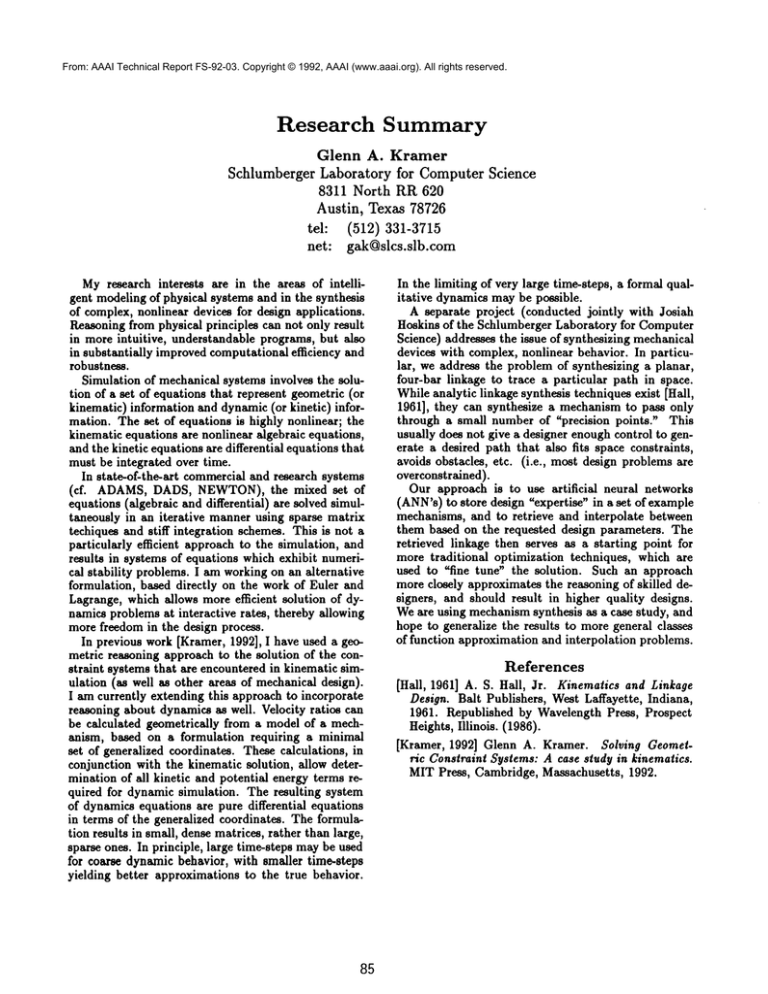
From: AAAI Technical Report FS-92-03. Copyright © 1992, AAAI (www.aaai.org). All rights reserved.
Research
Schlumberger
Summary
Glenn
A. Kramer
Laboratory
for Computer
8311 North RR 620
Austin, Texas 78726
tel:
net:
Science
(512) 331-3715
gak@slcs.slb.com
Myresearch interests are in the areas of intelligent modeling of physical systems and in the synthesis
of complex, nonlinear devices for design applications.
Reasoning from physical principles can not only result
in more intuitive, understandable programs, but also
in substantially improved computational efficiency and
robustness.
Simulation of mechanical systems involves the solution of a set of equations that represent geometric (or
kinematic) information and dynamic (or kinetic) information. The set of equations is highly nonlinear; the
kinematic equations are nonlinear algebraic equations,
and the kinetic equations are differential equations that
must be integrated over time.
In state-of-the-art
commercial and research systems
(cf. ADAMS,DADS, NEWTON), the mixed set
equations (algebraic and differential) are solved simultaneously in an iterative manner using sparse matrix
techiques and stiff integration schemes. This is not a
particularly efficient approach to the simulation, and
results in systems of equations which exhibit numerical stability problems. I am working on an alternative
formulation, based directly on the work of Euler and
Lagrange, which allows more efficient solution of dynamics problems at interactive rates, thereby allowing
more freedom in the design process.
In previous work [Kramer, 1992], I have used a geometric reasoning approach to the solution of the constraint systems that are encountered in kinematic simulation (as well as other areas of mechanical design).
I am currently extending this approach to incorporate
reasoning about dynamics as well. Velocity ratios can
be calculated geometrically from a model of a mechanism, based on a formulation requiring a minimal
set of generalized coordinates. These calculations, in
conjunction with the kinematic solution, allow determination of all kinetic and potential energy terms required for dynamic simulation. The resulting system
of dynamics equations are pure differential equations
in terms of the generalized coordinates. The formulation results in small, dense matrices, rather than large,
sparse ones. In principle, large time-steps maybe used
for coarse dynamic behavior, with smaller time-steps
yielding better approximations to the true behavior.
85
In the limiting of very large time-steps, a formal qualitative dynamics may be possible.
A separate project (conducted jointly with Josiah
Hoskins of the Schlumberger Laboratory for Computer
Science) addresses the issue of synthesizing mechanical
devices with complex, nonlinear behavior. In particular, we address the problem of synthesizing a planar,
four-bar linkage to trace a particular path in space.
While analytic linkage synthesis techniques exist [Hall,
1961], they can synthesize a mechanism to pass only
through a small number of "precision points." This
usually does not give a designer enough control to generate a desired path that also fits space constraints,
avoids obstacles, etc. (i.e., most design problems are
overconstrained).
Our approach is to use artificial
neural networks
(ANN’s)to store design "expertise" in a set of example
mechanisms, and to retrieve and interpolate between
them based on the requested design parameters. The
retrieved linkage then serves as a starting point for
more traditional optimization techniques, which are
used to "fine tune" the solution. Such an approach
more closely approximates the reasoning of skilled designers, and should result in higher quality designs.
Weare using mechanismsynthesis as a case study, and
hope to generalize the results to more general classes
of function approximation and interpolation problems.
References
[Hall, 1961] A. S. Hall, Jr. Kinematics and Linkage
Design. Bait Publishers, West Laffayette, Indiana,
1961. Republished by Wavelength Press, Prospect
Heights, Illinois. (1986).
[Kramer, 1992] Glenn A. Kramer. Solving Geometric Constraint Systems: A case study in kinematics.
MIT Press, Cambridge, Massachusetts, 1992.
